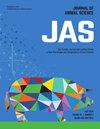膳食中添加硝酸盐对汉乌牛肠道甲烷产量、生产性能和瘤胃微生物组的影响
IF 2.9
2区 农林科学
Q1 AGRICULTURE, DAIRY & ANIMAL SCIENCE
引用次数: 0
摘要
通过体内实验评价硝酸铵钙(CAN;5Ca (NO3)2·NH4NO3·10H2O, 75% DM NO₃⁻)补充汉牛(韩国本土牛)肠道CH4排放、瘤胃发酵、微生物群落和生产力。选取20头平均体重为348±18 kg的汉乌阉牛,随机分配至体重平衡的5个栏(4头/栏),然后随机分配至2个饲粮处理(2头/处理/栏)中的1个处理:(1)对照(CON)、500 g/kg长茎草干草和500 g/kg商品精料;(2)采用完全随机设计,在饲粮中添加2.5% CAN (DM中添加1.578% NO3-),饲喂115 d。分别于第21、51、80和112天采用全身呼吸室(RC)测量3 d的甲烷含量。分别于第25天和第26天采集瘤胃液和血液样本。猪圈和对照区饲喂NIT的干物质采食量均显著降低(P < 0.05)。但对平均日增重和饲料增重无不利影响。此外,高铁血红蛋白的浓度没有受到治疗的影响,这表明用NIT喂养的no₃⁻stebers没有潜在的毒性。在整个饲养过程中,NIT的CH4产量(g/d)均显著降低(P < 0.05),但CH4产量(g/kg DMI)在不同处理间无显著差异(P < 0.05)。处理对瘤胃pH、氨浓度和总挥发性脂肪酸产量无显著影响,但与对照组相比,NIT组瘤胃乙酸和丁酸比例分别升高和降低(P < 0.01)。NIT组瘤胃Ruminococcus sp.丰度升高(P < 0.05),琥珀酸单胞菌和反刍硒单胞菌有升高的趋势(P = 0.07)。NIT降低了瘤胃中Olsenella、Atopobium的丰度(P < 0.05),并有降低反刍甲烷杆菌丰度的趋势(P = 0.07)。总的来说,随着时间的推移,在韩宇肉牛的饮食中补充NO₃⁻(克/天)有可能使肠道中CH4的产出量平均减少25.4%,而不会在早期引起NO₃⁻中毒,也不会对整个试验过程中的生长性能产生负面影响。然而,缺乏对CH₄产量(g/kg DMI)的持续缓解效果表明,在不同的饮食条件下进一步评估NO₃⁻补充是必要的。本文章由计算机程序翻译,如有差异,请以英文原文为准。
Effects of Dietary Supplementation of Nitrate on Enteric Methane Production, Performance and Rumen Microbiome of Hanwoo Steers.
An in vivo experiment was performed to evaluate the effects of calcium ammonium nitrate (CAN; 5Ca (NO3)2·NH4NO3·10H2O, 75% DM NO₃⁻) supplementation on enteric CH4 emissions, ruminal fermentation and microbial community and productivity in Hanwoo (Korean native cattle) steers. Twenty Hanwoo steers (average body weight 348 ± 18 kg) were randomly allocated to five pens (4 head/pen) balanced for body weight, and then randomly assigned to one of two dietary treatments (2 head/treatment/pen): (1) the control (CON), 500 g/kg long stem timothy hay and 500 g/kg commercial concentrates; (2) NIT, control diet top-dressed with 2.5% CAN (1.578% NO3- in the dietary DM) for 115 days in a completely randomized design. Methane measurement was performed for 3 days starting from d 21, d 51, d 80 and d 112 using whole body respiratory chambers (RC). Rumen fluid and blood samples were collected on d 25 and d 26, respectively. A decrease (P < 0.05) in dry matter intake (DMI) was observed in steers fed NIT both in the pen and RC. However, average daily gain and gain:feed were not adversely affected. Additionally, methemoglobin concentration was not influenced by the treatment, suggesting no potential toxicity of NO₃⁻ in steers fed NIT. A decrease (P < 0.05) in CH4 production (g/d) was noted in NIT throughout the feeding trial, but CH4 yield (g/kg DMI) was not different (P > 0.05) between treatments. Ruminal pH, ammonia concentration and total volatile fatty acid production were not affected by the treatment, but NIT increased and decreased (P < 0.01) acetate and butyrate proportions, respectively, compared with CON. Steers in NIT group had increased (P < 0.05) ruminal abundance of Ruminococcus sp. and a tendency for increased Succiniclasticum (P = 0.07), and Selenomonas ruminantium (P = 0.07). However, NIT decreased (P < 0.05) the abundance of Olsenella, Atopobium and tended to decrease (P = 0.07) Methanobrevibacter ruminantium in the rumen. Overall, dietary supplementation of NO₃⁻ demonstrated a potential to reduce enteric CH4 production (g/d) by an average of 25.4% in Hanwoo beef cattle over time without causing NO₃⁻ intoxication in the early stage or negatively affecting growth performance throughout the trial. However, the lack of a sustained mitigation effect on CH₄ yield (g/kg DMI) suggests that further evaluation of NO₃⁻ supplementation under different dietary conditions is necessary.
求助全文
通过发布文献求助,成功后即可免费获取论文全文。
去求助
来源期刊

Journal of animal science
农林科学-奶制品与动物科学
CiteScore
4.80
自引率
12.10%
发文量
1589
审稿时长
3 months
期刊介绍:
The Journal of Animal Science (JAS) is the premier journal for animal science and serves as the leading source of new knowledge and perspective in this area. JAS publishes more than 500 fully reviewed research articles, invited reviews, technical notes, and letters to the editor each year.
Articles published in JAS encompass a broad range of research topics in animal production and fundamental aspects of genetics, nutrition, physiology, and preparation and utilization of animal products. Articles typically report research with beef cattle, companion animals, goats, horses, pigs, and sheep; however, studies involving other farm animals, aquatic and wildlife species, and laboratory animal species that address fundamental questions related to livestock and companion animal biology will be considered for publication.
 求助内容:
求助内容: 应助结果提醒方式:
应助结果提醒方式:


